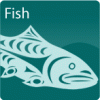Chinook Salmon


HABITAT:
Freshwater streams and estuaries provide important habitat for chinook salmon
DIET:
Chinook salmon feed on terrestrial and aquatic insects, amphipods, and other crustaceans while young, and primarily on other fish when older
PREDATORS:
Resident Killer Whales
Identification
Chinook salmon weigh between 1.5 - 30 kg.
After hatching, chinook remain in fresh water for varying lengths of time, depending on water temperature. In southern areas, some migrate after three months in fresh water while others may remain for up to a year. In northern areas, most chinook spend at least a year in fresh water. These fish are known to migrate vast distances and are found sparsely distributed throughout the Pacific Ocean. The age of chinook adults returning to spawn varies from two to seven years. Many river systems have more than one stock of chinook, some even having spring, fall and winter runs.
Life History
Chinook salmon live in rivers, streams and coastal waters.
Chinook salmon are known as piscivorous, meaning that they eat other fish.





